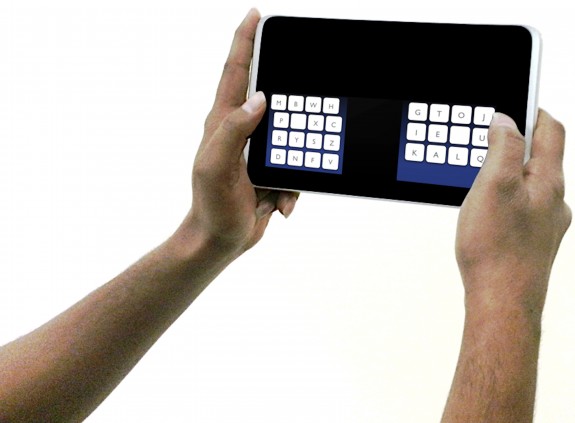This Is the New, Non-QWERTY Keyboard You Will Use to Compose Your Thumb-Powered Opus
A new keyboard layout could fix two-thumb typing

The KALQ keyboard layout. Photo: Outlasvirta et al.
In 2012, says the New York Times, “cellphone owners sent an average of 678 texts a month.” That’s a lot of messages, and we’re guessing at least half of those messages were sent in a bid to correct all the spelling mistakes in the other half. The teeny little thumb-powered QWERTY keyboards we use to send Facebook updates, tweets, emails, iChats and Gchats are a holdover from the typewriter era of the 1870s, and they are a terrible tool for two-fingered tapping.
Programs like Swype have tried to make QWERTY work a little better, but they’re mostly band-aid solutions to a festering wound. Now, computer science researchers lead by Antti Oulasvirta at the Max Planck Institute in Germany think they have a true solution, a way to improve smartphone and tablet typing. They want to replace the QWERTY keyboard that we could all probably lay out in our sleep with a new keyboard design called KALQ.
KALQ is designed specifically for two-thumb typing and is built to maximize a sort of left hand-right hand rhythm. Pacific Standard:
The trick to building a better keyboard, according to the researchers, is to maximize the number of alternate-thumb keystrokes—try typing “minimum” on your QWERTY iPhone and you’ll understand why—and minimize overall “thumb travel” distance.”
On top of rearranging the letters, the keyboard doesn’t have a spacebar. Because if you really care and spend a lot of time thinking about these sorts of things, moving down to hit the spacebar takes unnecessary time and slows you down. So, “instead of a spacebar, which requires the thumb to travel all the way to the bottom of the screen, two “blank” keys—one for each thumb—are found on the centrally located home-row.”
People who tried KALQ out were at first, understandably, slower than they were typing on a QWERTY keyboard. But, after a bit of practice, they were much faster. The researchers plan, they say, to release the keyboard layout for free to Android device users next month.
More from Smithsonian.com:
Text President Lincoln
Stop Texting While You’re Walking
The First Text Message, Sent Twenty Years Ago, Was ‘Merry Christmas’
/https://tf-cmsv2-smithsonianmag-media.s3.amazonaws.com/accounts/headshot/smartnews-colin-schultz-240.jpg)
/https://tf-cmsv2-smithsonianmag-media.s3.amazonaws.com/accounts/headshot/smartnews-colin-schultz-240.jpg)